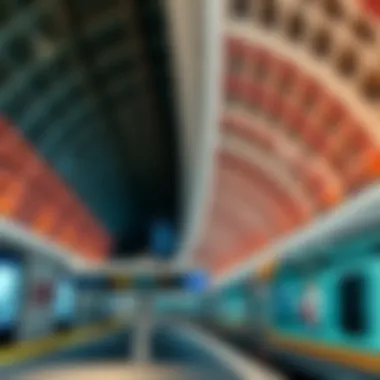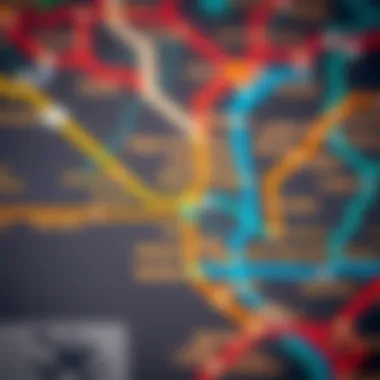Exploring the Naming of Dubai's Metro Stations


Intro
Dubai's metro system isn't just a means of transportation; it is a reflection of the city's dynamic spirit and growing urban landscape. The station names tell a story, each one echoing the cultural, historical, and practical significance of the locations they represent. Understanding these names provides deeper insights into how Dubai is evolving and how it positions itself on the global stage.
As we embark on this exploration, we will examine the underlying themes that shaped the naming conventions of metro stations. The significance of these names goes beyond mere labels; they resonate with the aspirations of the residents and the ambitions of a city in constant flux. From historical landmarks to emerging commercial hubs, each name has its own tale to tell.
This examination will also provide valuable insights for investors and homebuyers looking to navigate Dubai's ever-changing real estate landscape. By aligning with the metro stations' significance within urban development, one can uncover opportunities that go hand in hand with the city's growth trajectory.
Thus, this piece aims to weave together the threads of history, culture, and urban planning, revealing how the naming of metro stations is reflective of broad societal shifts and individual choices in the bustling city of Dubai.
Market Insights
Current Trends in Dubai Real Estate
In the realm of real estate, the naming of metro stations often correlates with market dynamics. Station names frequently serve as markers of areas experiencing revitalization or rapid development. For example, neighborhoods near the Burj Khalifa station or the Mall of the Emirates station have seen a surge in property values due to increasing foot traffic and popularity among residents and tourists alike.
Significant changes in station accessibility have shown a direct impact on surrounding property values, making these areas highly sought after.
Another noteworthy trend is the growth of mixed-use developments surrounding metro stations. Investors are keenly aware of this shift and are looking for properties that integrate living, working, and leisure spaces, a preference echoed in Dubai's progressive real estate strategies.
Analysis of Future Predictions
Looking ahead, several forecasts suggest that the development of new metro stations will stimulate growth in previously overlooked areas. For instance, the anticipated extensions to the metro network could rapidly increase demand for properties in emerging suburbs. This anticipation could lead to a property boom as more commuters see the benefits of living near metro lines.
Investors may find it prudent to keep an eye on the proposed extensions and the naming of future stations, as these developments could profoundly influence market behavior and property valuations. The integration of technology and sustainable practices in upcoming projects presents yet another layer of insight into Dubai's strategic direction.
Investment Strategies
Tips for First-Time Investors
For novice investors, aligning with the metro station names can provide a clear framework for decision-making. Here are some considerations:
- Research the Area: Understand the demographic and economic background of surrounding neighborhoods. The station names can guide you to areas with historic significance or emerging potential.
- Focus on Accessibility: Properties near busy metro stations tend to appreciate faster. Look for those that will become key transit points as the network expands.
- Consider Future Developments: Explore the future plans for metro extensions and new stations. If a station is on the drawing board, investing early can yield substantial returns.
Understanding Property Valuation
Property valuation in Dubai can seem like a daunting task. However, the proximity to metro stations can significantly influence value assessments. To make sense of property valuations, consider the following factors:
- Proximity to Key Stations: Station names associated with landmarks or popular destinations typically command higher prices.
- Accessibility: Evaluate how easily one can access these stations from the property and the potential for increased foot traffic.
- Area Growth Potential: Stations located in areas with active urban development plans are likely to experience faster appreciation.
In summary, understanding the nuances of Dubai's metro station names and their implications on real estate can empower investors to make informed decisions. A thoughtful evaluation of trends, combined with a strategic approach to investment, ensures that one can thrive in this dynamic market.
Prelims to the Dubai Metro System
The Dubai Metro is more than just a transport network; it's a vital artery pulsing through the heart of one of the fastest-growing cities in the world. Launched in 2009, this modern marvel serves not only as a means of transport but as a symbol of Dubai's ambition and prosperity. The importance of this system cannot be overstated. It plays a crucial role in easing traffic congestion, reducing travel times, and providing an accessible alternative to the often chaotic urban commute.
The metro system reflects Dubai's urban identity, shaped by its cultural mosaic and rapid development. With over 75 kilometers of track and numerous stations, it connects key areas, including business districts, shopping centres, and residential hubs. For investors, property managers, and homebuyers, understanding the layout and names of these stations is essential. The station names carry not only functional significance but also cultural and economic implications.
Benefits of the Dubai Metro
Using the metro comes with a ton of benefits:
- Cost-effective Travel: Commuting via the metro is significantly cheaper compared to driving or using ride-sharing services.
- Environmental Impact: The metro system drastically reduces carbon emissions, making it an eco-friendly choice for residents.
- Convenience and Accessibility: Extensive coverage ensures that most of the city is reachable within minutes, enhancing mobility for everyone, be it a tourist or a long-time resident.
Considerations
When exploring the effectiveness of the metro system, several considerations arise:
- Future Development: With further expansions underway, the metro will cover even more of the city, potentially increasing the value of properties located near new stations.
- Integration with Other Forms of Transport: The seamless linkage with buses and taxis adds layers of convenience that can not be overlooked.
Overall, the Dubai Metro stands as a testament to the city’s foresight in urban planning. As we delve into the cultural significance of station names and their implications on real estate, it's essential to grasp the foundational role that this transport system plays in shaping urban life in Dubai.
"A city’s soul is often reflected in its transport systems; they reveal both its past and its vision for the future." - Unattributed


By understanding the metro, we uncover more than a transportation method; we explore bridging communities and fostering growth.
Historical Context of Metro Station Development
The development of the Dubai Metro system is more than just a transportation project; it is a symbol of the city's transformative urban ambitions. As an investor, homebuyer, or property manager, understanding this historical context is crucial not only to appreciate the infrastructure itself but also to grasp its implications for real estate and urban development in Dubai.
A significant facet of this context lies in how the metro system underscores Dubai's rapid transition from a modest trading port into a global city. This transition can be traced back to the late 20th century when various infrastructure initiatives were embarked upon, aiming to modernize the city while addressing the increasing challenges of urban sprawl and traffic congestion.
The Vision Behind Dubai's Urban Transport
In the early stages, the vision for Dubai’s urban transport was ambitious. City planners recognized that a robust public transportation system would not only ease mobility but also elevate the city's international profile. The driving idea was to create a metropolitan framework that would connect key urban zones while serving millions of residents and tourists.
Planners adopted a modern perspective, looking towards sustainable growth. They envisioned a network that was seamlessly integrated with roadways and pedestrian pathways, catering to the needs of both locals and the anticipated influx of diverse populations induced by globalization. By opting for a metro system over extensive road expansions, Dubai displayed foresight—placing a premium on long-term viability over immediate expansion.
"Public transport is not just about moving people; it's about forging connections that drive economic growth and cultural exchange."
Milestones in Metro Construction
The construction of the Dubai Metro was marked by notable milestones that reflect the commitment to innovation and speed. Groundbreaking began in 2006, marking the start of an ambitious endeavor. The Red Line, which spanned approximately 52 kilometers, was inaugurated in 2009, merely three years later. This rapid construction pace was not only impressive but set a precedent for future projects in the region.
A few key milestones stand out:
- 2006: Construction begins; a phased approach allows for quick updates and adaptability in project planning.
- 2009: The opening of the Red Line introduces the world to the first fully automated, driverless metro system in the Middle East, showcasing cutting-edge technology.
- 2010: The Green Line is launched, further expanding connectivity and access across the city while enhancing local transportation options.
These milestones reflect not only speed but also an openness to adopting the latest technologies—an aspect that continues to define Dubai’s urban identity. The strategic placements of the stations highlight the foresight in navigating economic hubs and tourist attractions, ensuring that transportation aligns with metropolitan growth.
With the current expansions planned, the historical context of these developments becomes even more relevant. For an investor or homebuyer, reviewing the past decisions and developments in the metro system can impart invaluable insights regarding future opportunities and the lasting value of properties adjacent to these transit lines.
Cultural Significance of Station Names
The names of Dubai's metro stations are not mere labels; they are vital signposts of the city’s identity. They encapsulate layers of local history, culture, and aspirations, suggesting the tapestry of Dubai's rapid development and vibrant lifestyle. Understanding these names offers insights into how culture and heritage interplay with modern urban planning. For investors and homebuyers, digging deeper into the significance behind each name reveals stories that can influence real estate valuations and community development strategies.
Incorporating Local Heritage
Dubai's metro station names often act as vessels of heritage, echoing the natural, historical, or social characteristics of the landscapes they occupy. Each name emerges from the localized context, often pointing to geographical features or notable historical sites within the emirate. For instance, places named after traditional markets or landmarks, such as Al Souk Al Kabeer, remind residents and visitors of Dubai’s trading roots—the very foundation of its economy.
The inclusion of such names fosters a sense of belonging among commuters. They are reminded of their rich cultural connections each time they enter a station. This cultural mindfulness can resonate strongly with homebuyers and investors, as properties near such heritage-infused station names might be perceived as more desirable, blending modern living with traditional identity.
Influencing Community Pride and Unity
For local communities, these names instill pride and cultivate a distinctive urban identity. When residents feel that their cultural heritage is recognized and celebrated in the infrastructure of the city, it fosters unity, making navigation through the city a shared experience. The more people connect to the narrative behind the names, the better they engage with the urban environment. Recognizing the historical significance imbued in station names can transform transit routes into cultural corridors, enhancing the commuting experience.
Influence of Emirati Traditions
Emirati traditions play a crucial role in shaping the names of the metro stations. The use of names that pay homage to key historical figures, events, or traditional practices allows for an ongoing dialogue between the past and present. For example, station names like Al Jafiliya resonate deeply with local traditions and evoke feelings of nostalgia and heritage among Emiratis.
Representation of Social Fabric
The integration of traditional elements in naming can also reflect the diverse social fabric of the UAE. Names may reference various tribes, professions, or practices that signify unity in cultural diversity. This recognition encourages an understanding of the country’s complex social dynamics, which could be beneficial for investors looking at the properties near such stations.
Cultivating Inclusivity
Moreover, incorporating Emirati traditions fosters inclusivity. Providing station names that honor the past opens avenues for collaboration among both long-time Emiratis and newcomers to the city. This sense of inclusivity can reverberate through neighborhoods, influencing livability, investment opportunities, and, ultimately, the city’s overall appeal.
In summary, the cultural significance of Dubai's metro station names is multi-faceted—they are not just functional descriptors but are imbued with heritage and tradition that shapes the urban identity. For those accompanying this exploration, acknowledging the values embedded within these names will illuminate future investment and lifestyle choices.
Culmination: A Gateway to Understanding Dubai
Exploring the cultural significance of station names is essential in comprehending the broader strokes of Dubai's ambitions. For property managers and homebuyers intrigued by how culture has a tangible impact on infrastructure, understanding these names is not just an academic exercise; it is crucial for making informed decisions in a city that thrives on innovation while grounding itself in tradition.
Naming Conventions: Strategies and Themes
The naming of Dubai's metro stations is not a mere administrative task; it reflects a deliberate strategy embodying the city’s vision, aspirations, and cultural richness. Understanding these naming conventions reveals layers of meaning behind each title. This section delves into the intricate strategies employed to name the metro stations, shedding light on their broader significance in urban planning and community identity.
Track Record of Geographic Names


The practice of using geographic names in the arts of naming public transportation hubs is neither new nor stray from the global norm. In the case of Dubai Metro, station names often draw upon notable landmarks or geographical features identifiable to both locals and tourists. Addressing the geographic names offers iconic references, fostering a sense of familiarity.
For instance, Burj Khalifa/Dubai Mall Station encapsulates two of the city's most significant attractions, bridging the gap between transportation and tourism. This intersection not only aids in wayfinding but also aligns public transport with city landmarks, thereby enhancing the commuting experience for residents and visitors alike.
The selective choice of geographic terms fosters not just navigation but also a deeper connection to the city's identity. For many, simply uttering names of these stations stirs feelings of pride and attachment, which is crucial in a rapidly changing urban landscape.
Recognition of Economic Hubs
Moving beyond geographic identifiers, naming conventions also place emphasis on economic significance. Certain stations are deliberately named to spotlight bustling commercial areas, thereby reinforcing their role in the local economy. Dubai Marina Station is a prime example; it anchors the name in a thriving leisure and residential neighborhood, echoing its economic reality.
Furthermore, strategically naming stations like Deira City Centre Station highlights not just the present-day shopping and business opportunities, but also aims to attract future investments. Investors looking at these areas understand that proximity to transport hubs correlates to property value appreciation and market demand.
"Every station name has a role to play; they are not just names, but indicators of growth, potential, and collective memory for the community."
In this light, station names become signatures of economic hubs, encapsulating the commercial essence of their surroundings. They serves as beacons for investors and property managers, guiding decisions based on geographic positioning and commercial viability, which are paramount in Dubai's dynamic real estate market.
In summary, the naming strategies that define the Dubai Metro system encapsulate a blend of geographic relevance and economic recognition. These names do far more than facilitate navigation; they encapsulate Dubai's urban identity, aspirations, and the intricate dynamics of its expansion. This comprehensive approach to naming is a microcosm of the city itself—one that evolves yet remains deeply rooted in its heritage and forward-looking vision.
Overview of Key Dubai Metro Stations
The Dubai Metro, a marvel of modern urban transport, intricately weaves through the city's bustling landscape. Examining key stations reveals not only their practical importance for commuters but also their role as cultural and economic landmarks. Each station acts as a hub that reflects the character of its surrounding area, contributing to the city's unique identity.
Understanding the significance of these stations is essential for investors and homebuyers alike. When considering property investments, proximity to a metro station often influences both attractiveness and value. Stations become focal points for commercial and residential development, affecting trends in property pricing in their vicinity.
Burj Khalifa/Dubai Mall Station
Nestled under the shadow of the iconic Burj Khalifa, this station serves as a major gateway for both tourists and locals. Opened in 2010, it directly links to one of the world's largest shopping centers, Dubai Mall. The strategic placement of this metro station has an undeniable influence on the real estate market around it.
- Features: The station boasts elegant design elements, complementing the luxurious aura of the Burj Khalifa.
- Economic Impact: The station’s presence boosts foot traffic significantly, making adjacent properties more valuable. Businesses thrive around this area due to the influx of shoppers and tourists.
In essence, being close to this station can provide immense benefits for investors looking at commercial ventures in high-traffic areas.
Deira City Centre Station
This station stands as a vital connection point in one of Dubai's oldest districts. Deira is known for its rich history and bustling marketplaces, and the metro station here plays a pivotal role in supporting local commerce. Deira City Centre itself is a hub of activity, housing numerous retail shops and dining possibilities.
- Cultural Relevance: The station fosters connections between old and new Dubai, bridging traditional markets with contemporary urban life.
- Growth Potential: The Deira area has experienced revitalization efforts, making properties nearby particularly appealing. Investors looking for up-and-coming areas might find this station offers excellent opportunities.
As community developments continue, proximity to the Deira City Centre Station might signal a wise move for forward-thinking real estate ventures.
Dubai Marina Station
Dubai Marina Station encapsulates the essence of modern Dubai living, surrounded by luxury high-rises and waterfront views. This station provides easy access to one of the city's most desirable residential areas, serving a demographic that includes expatriates and affluent locals.
- Lifestyle Appeal: The station not only facilitates metro travel but also enhances the lifestyle of residents. It connects them to beach leisure, dining, and entertainment options seamlessly.
- Real Estate Insights: Properties near this station maintain a high desirability factor, particularly among young professionals and families seeking convenience and quality of life.
Investors should note that areas around Dubai Marina continue to develop, which bodes well for property value appreciation in the coming years.
In summary, the overview of key Dubai Metro stations reveals their multifaceted importance both for daily commuters and the broader economic landscape of the city. Investors and property managers must pay keen attention to station locations, as they can serve as a barometer for real estate potential in this ever-evolving metropolis.
Impact of Station Names on Real Estate
In the ever-evolving landscape of Dubai's real estate market, the naming of metro stations plays a pivotal role that often goes overlooked. The connection between infrastructure and property values is crucial. The impact of the Dubai Metro station names offers a glimpse into how urban planning and commercial growth intersect. This section will unpack how station names not only affect property valuations but also attract investors seeking lucrative opportunities in the vibrant cityscape.
Property Valuation Trends Near Metro Stations
When it comes to buying or investing, location is king. That’s a saying that rings true in real estate, and nothing illustrates this better than the vicinity of metro stations. A study by the Dubai Land Department indicates that properties closer to metro stations experience a tangible increase in value.
Consider properties near the Burj Khalifa/Dubai Mall Station. They boast not only prime placement but also high demand stemming from the station's name recognition. People flock to the area, be it for its iconic attractions or the convenience the metro offers. This blend of desirability and accessibility translates directly into higher property prices.
"Accessibility to transport hubs like metro stations can elevate property prices by up to 20% in Dubai's competitive market."
Similarly, areas around the Dubai Marina Station draw significant interest from both local and international buyers, aiming to capitalize on the lifestyle offerings presented by such a scenic transit stop.
This highlights a vital consideration for potential buyers and investors: the station names may function as market indicators. Properties in carefully selected neighborhoods with strategic transportation links not only appreciate in value, but they also show resilience against market fluctuations.


Attractiveness to Investors
Investors consistently hunt for golden opportunities, and while traditional factors like price and location matter, transportation accessibility has become a game changer. Station names can provide deeper insights into the characteristics of the area they represent.
Investors are keenly aware that properties near metro stations often come with lower vacancy rates. Residents are increasingly drawn to the convenience, thus solidifying a stable tenant base. The key names, like Deira City Centre and Dubai Marina, are obvious draws, yet it’s the lesser-known stations that might hold secret gems. For example, Al Rigga Station is less glamorous but benefits from emerging neighborhoods with rising property interest.
Moreover, various developers are taking cues from the metro's planned expansions. Upcoming stations are often heavily discussed in property circles, as potential future value rises. Investing near these sites can lead to significant returns as development progresses.
In summary, station names have a substantial influence on investments. They can serve as both indicators of current value and predictors of future potential. Investors should take heed: navigating the intricate web of metro station names might just lead to a profitable path in Dubai's thriving real estate market.
Public Perception and Community Engagement
Understanding the sentiments of residents and commuters is essential when discussing the Dubai Metro stations. This aspect of public perception shapes how people interact with the metro system, and it also paints a broader picture of community engagement within Dubai's urban landscape. Public perception impacts not just how a transport system is viewed but also how it can foster a sense of belonging and identity among its users. Fostering this connection with the community can lead to several benefits, such as increased ridership and heightened appreciation for urban transit systems.
Feedback from Residents and Commuters
Gauging feedback from local residents and daily commuters offers vital insights into how the metro is perceived in everyday life. For example, many commuters appreciate the reliability and efficiency of the metro system but may express concerns about overcrowding during peak hours. This feedback loop is crucial; it indicates where improvements are necessary and where the metro system excels.
There are forums and local community meetings where citizens voice their thoughts. For instance, postings on platforms like reddit.com often spark discussions regarding the Dubai Metro experience, from cleanliness standards to the punctuality of the service. One especially common point of contention is the accessibility for people with disabilities. These sentiments are reflective of the community's broader expectations and aspirations. Listening to these voices can lead to service improvements and a more robust community feel regarding the metro system.
Community Events and Metro Awareness
Community events serve as a platform to bridge gaps between the metro service and its users. Metro awareness campaigns often bring people together, highlighting the importance of public transport in a growing metropolis like Dubai. They can encompass anything from safety workshops to family-friendly festivals that promote the use of the metro.
Local organizations and the metro authority often collaborate to organize these events, creating an environment where education meets engagement. Moreover, using social media platforms such as facebook.com to promote these events ensures that they reach a broader audience, enticing even those who do not normally use public transport to participate in the conversation. These interactions not only improve the public’s understanding of the metro’s offerings but also instill a sense of pride in the community's transportation achievements.
"Effective community engagement in urban transit can transform stigmas around public transport into strong community ties."
Ultimately, fostering a good relationship between the metro system and the public not only enhances user experience but can lead to practical solutions that reflect the community’s needs.
Future Developments and Naming Prospects
In the dynamic urban landscape of Dubai, the future developments of the metro system hold significant promise. As the population grows and the demand for efficient transportation increases, the metro network is set to expand further. This expansion not only enhances mobility but revitalizes local economies and integrates newer neighborhoods into the city’s fabric. The naming of new stations will play a key role in this context, reflecting the identity and aspirations of the areas they serve.
Expansion Plans for the Metro Network
The Dubai Metro is not just a transport system; it is a vital part of the city’s development strategy. Future expansion plans are aimed at connecting the dots across various districts, thereby ensuring seamless travel for residents and tourists alike. Key expansions include:
- New Lines: Proposals are in place for additional lines that will link emerging residential and commercial areas. These routes will cater to the growing number of commuters seeking reliable transportation options.
- Extended Reach: Current lines may be extended to cover underserved regions, ensuring that areas like Al Quoz or Dubai South receive direct access to downtown. This is crucial for urban development.
- Sustainability Initiatives: Consideration for eco-friendly solutions during construction and operation of the expanded metro will be a priority. The introduction of energy-efficient trains and renewable energy resources can underscore Dubai’s commitment to sustainability.
Ultimately, these developments provide a robust framework for enhancing connectivity while simultaneously boosting property values in adjacent areas.
Evolving Naming Trends
As the metro network grows, the approach to naming stations will likely evolve. There are several factors that influence how new station names are chosen:
- Cultural Relevance: Names may reflect the local heritage, tourism attractiveness, or landmark significance. For example, incorporating the names of notable Emirati figures or events that resonate with the community can enhance local pride.
- Economic Significance: With the introduction of various economic hubs, reflecting this in naming could reinforce the commercial appeal of the areas. It will be vital for potential investors and homebuyers as they seek locations with strong growth potential.
- Public Engagement: Involving residents in the naming process can build a sense of ownership and communal identity among them. Such participation may involve polls or community meetings where options for names are discussed, aligning the station identity with the desires of the people who use it.
The significance of a name can’t be understated; it goes beyond mere identification. It can enhance urban identity, foster community connection, and reflect the ongoing evolution of Dubai.
In summary, as Dubai's metro system continues to grow, both the extensions of the network and the naming of future stations will be integral in shaping the city's urban narrative.
End: The Role of Names in Urban Identity
Names are like windows into a city's soul, particularly in a constantly evolving urban landscape such as Dubai. They offer more than just identification; they embody history, culture, and a vision for the future. The naming of metro stations isn't merely an administrative task; it's a thoughtful process that reflects a city's identity and aspirations. This article has explored how Dubai's station names provide a narrative of the city itself, blending the past with present realities and future ambitions.
Importance of Station Names
The station names in the Dubai Metro network can significantly shape public perception and individual identity within the urban space. When commuters hear names like Burj Khalifa/Dubai Mall, it triggers imagery, associations, and emotions tied to economic prowess and modernity—conveying the luxurious yet accessible lifestyle that Dubai promotes.
"Station names reflect a community's identity and ambitions, tapping into a collective sense of belonging."
Cultural Reflections
Names serve as a bridge connecting residents to their heritage. Incorporating elements of local culture and tradition provides an enriching narrative context for both residents and visitors. For instance, stations named after historic districts or local landmarks bolster the essence of identity and encourage exploration of the culture around them.
Economic Considerations
From an investor's perspective, station names are not just about branding; they often indicate the significance of the area and its potential for property valuation. Locations near key stations tend to fetch higher prices, as the convenience of access inherently enhances their attractiveness. Thus, understanding the significance behind the names can give a leg up in making informed investment decisions.
Ending on Urban Identity
By investing time to understand the importance of naming within the Dubai Metro system, investors, homebuyers, and property managers can navigate the urban landscape with renewed insight and deeper appreciation. The discourse surrounding station names is, indeed, a reflection of a larger journey—a journey from the past to the bright horizons of the future.













